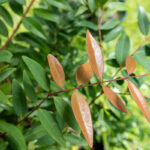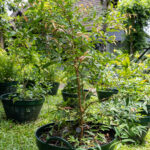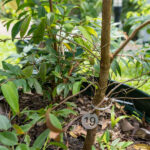จันผา (Chan Pha) – Wild Cinnamon
Family: Myrtaceae
Syzygium antisepticum, known locally as จันผา (Chan Pha), is an evergreen shrub or small tree native to Southeast Asia. It is closely related to clove and other Syzygium species. The plant is recognized for its aromatic leaves, reddish new shoots, and smooth bark, and is both a medicinal and sacred tree in Thai culture.
Botanical Characteristics
Wild Cinnamon grows 2–8 meters tall with dense, glossy foliage. Young leaves are copper-red, turning bright green as they mature. The small white flowers appear in clusters, followed by red or purple edible fruits. Its natural oils give off a warm, cinnamon-like fragrance when crushed.
Use in Thai Traditional Medicine
In Thai herbal medicine, จันผา (Chan Pha) is prized for its antiseptic and anti-inflammatory properties. Decoctions made from the bark and leaves are used to cleanse wounds, reduce fevers, and treat respiratory conditions. The aromatic oils are also used to refresh indoor air and repel insects. Spiritually, it is considered a plant that brings calm and purity to its surroundings.
Cultural and Spiritual Significance
The wood and leaves of Syzygium antisepticum are used in Buddhist rituals for cleansing and protection. It is often planted near temples or shrines as a sacred species believed to ward off negative energy. The pleasant fragrance of the new leaves symbolizes clarity of mind and moral purity.
Cultivation Notes
Wild Cinnamon thrives in full sun or light shade and prefers moist, well-drained soil. It grows easily in tropical climates and can be pruned into ornamental shapes. The reddish new leaves make it a favorite for decorative and spiritual gardens alike.
Historical Context
Historically, species of the Syzygium genus have been used across Asia for their aromatic and medicinal qualities. In Thailand, จันผา has held a place in both traditional healing and religious practice, representing a bridge between natural medicine and cultural heritage.
Disclaimer: This information is provided for educational and historical purposes only. It is not intended as medical advice. Always consult a qualified healthcare professional before using any herbal preparation.




